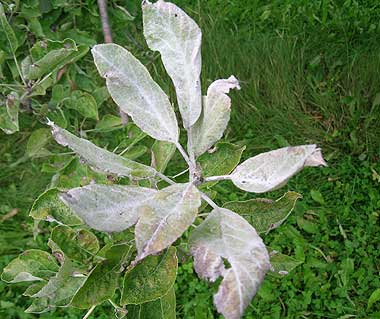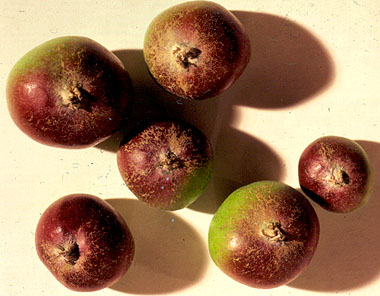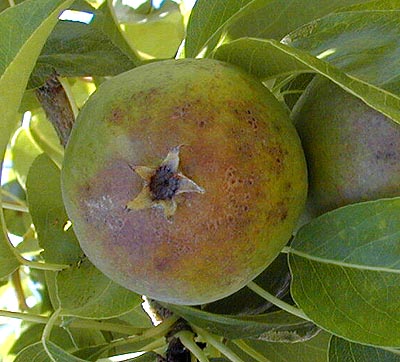Apple and Pear Powdery Mildew
There are several species of powdery mildew that attack tree fruit. Apple and pear are affected by Podosphaera leucotricha, while stone fruits are affected by Podosphaera clandestina and Sphaerotheca pannosa. Mildew can infect both the leaves and the fruit, and may render fruit unmarketable.
Symptoms:
Apple: The fungus produces a white powdery growth on new terminal growth, leaves and developing fruit. Later in the spring, as the fungus dries and is sloughed off, a network of russet appears on the infected surface of the fruit.
Pear: Powdery mildew on foliage of pears is less evident than in apples. However pears are susceptible to fruit infection, which appears as black marks and russeting on young fruit.
 |
| Powdery mildew on apple leaves |
 |
| Powdery mildew-induced russet on apple |
Life Cycle:
Apple: The powdery mildew fungus overwinters in terminal buds. Severe winter temperatures can reduce mildew pressure by killing infected buds, which are more susceptible to winter injury than healthy buds. As infected buds open in the spring, spores (conidia) are released to initiate primary infections on blossoms, young leaves and fruit. Infections causing fruit russet can occur from about 3 weeks before bloom to 3 weeks after bloom. Additional conidia are produced on infected leaves and fruit which cause secondary infections. There are multiple generations per year, with trees susceptible as long as they are actively growing. Powdery mildew is favoured by moderate temperatures (10-25 °C) and high relative humidity.
Pear: Powdery mildew does not overwinter in pear buds, as it does on apple. Primary inoculum affecting pears originates from nearby apple orchards.
Dormant Monitoring:
The number of mildew sprays required on bearing trees prior to blossom can be predicted by estimating the percentage of one-year old shoots showing white fungus on the bark surface during the dormant season. If more than 15% of one-year-old shoots have mildew, two pre-bloom sprays are required. Spray once prior to bloom for mildew levels between 5 and 15%. No pre-bloom spray is needed if the mildew level is below 5%. Note that eliminating all pre-bloom sprays may increase the risk of damage on highly susceptible varieties.
Cultural Control
- Avoid overcrowding of trees and branches.
- Prune out twigs with white fungus growth on the surface.
- Avoid planting Anjou pears within 200 m of susceptible apple cultivars. Bartlett, Flemish Beauty and Winter Nelis are more resistant to powdery mildew.
Chemical Control
Apple:
- There are numerous fungicides registered for control of powdery mildew on apple. Please refer to the BC Tree Fruit Production Guide for current fungicide recommendations. Follow the product labels for application instructions and precautions.
- Early spring applications of fungicide (beginning no later than tight cluster) are necessary to prevent secondary spread of powdery mildew in susceptible apple varieties. Neglecting control early in the year will result in poor control during the season.
- Foliage - A single pink spray will not protect the foliage of susceptible varieties such as Honeycrisp, McIntosh, Granny Smith, Gala, Jonagold and Ginger Gold. Two pre-bloom sprays are needed for good control of powdery mildew where disease levels are high. Apply fungicides at 10-day intervals or as labels direct, from tight cluster until terminal growth ceases, to keep foliage free of mildew and to reduce carry-over to the next season. Control of foliage powdery mildew is particularly important in nurseries and on young trees. On more resistant varieties such as Red and Golden Delicious, damage from moderate amounts of mildew on terminal growth is relatively minor and does not warrant an extensive spray program.
- Fruit - Fungicide application at the pink stage is a critical timing to prevent fruit infection and subsequent fruit russeting.
- Resistance management - Rotate between different chemical groups to help prevent the development of fungicide resistance. Use recommended rates for powdery mildew control. Reduced rates will result in poor control and an increased risk for resistance development. Limit sprays of group 3 (Nova, Inspire, Fullback, Aprovia Top) and group 11 fungicides (Sovran, Pristine, Flint) to 2 per season for each group.
- To prevent fruit infection and russeting, apply a recommended fungicide at the full white stage.
- Please refer to the BC Tree Fruit Production Guide for current fungicide recommendations. Follow the product labels for application instructions and precautions.
|
|
|
Powdery mildew damage to pear fruit. |
Updated July, 2018
Related Links
AgriService BC
Have a question? Call or email us.
Toll Free: 1-888-221-7141
E-mail: AgriServiceBC@gov.bc.ca

